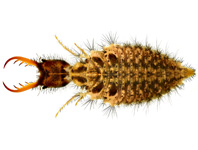Abstract
Temnocephala iheringi Haswell, 1893 was recorded in Marisa planogyra Pilsbry, 1933 and Pomacea maculata Perry, 1810. Also, Temnocephala amatoi sp. nov. was described from Pomacea scalaris (d’Orbigny, 1835). The mollusks were collected from temporary ponds at Ypiranga Farm, Poconé, Mato Grosso, Brazil. The new species differs from six other species of Temnocephala Blanchard, 1849 epibionts on molluks by having the following combination of characters: 1. a short and curved cirrus; 2. a narrow introvert with approximately 22 longitudinal rows of spines with 13 spines each; 3. internal spines with a narrow base, longer on the base of the introvert and smaller in the distal portion; 4. a single and asymmetrical vaginal sphincter and; 5. elliptical, longer than wide epidermal ‘excretory’ syncytial plates (EPs) with a excretory pore displaced to the anterior portion of the plate. Temnocephala lamothei Damborenea & Brusa, 2008 has a curved cirrus, similar in size to the new species’ cirrus. However, the introvert is not swollen with an oblique proximal margin, marked with a thickened oblique ring and two rows of 45–50 thin spines, differentiating the species from T. amatoi sp. nov.. When comparing the specimens of T. iheringi from Poconé with the redescription of the species from Southern Brazil previously published by the authors, we found significant intraspecific variation in the size of the adhesive disk, pharynx length, shaft and introvert length, spines of the introvert length, as well as differences in the number of paranephrocytes. The size of the EPs and, when comparing with published data from Uruguayan and Argentinean specimens, the body size also showed important differences. We hypothesize that the host species may be the cause of the intraspecific variations found. Overall, the record of two new hosts for T. iheringi, the intraspecific variation found in this species and its geographical distribution being expanded 418 km further to the north, together with the description of a new species, add acknowledgment to the Rhabdocoela fauna in the Brazilian Pantanal.
References
Amato, J.F.R., Seixas, S.A. & Amato S.B. (2007) A new species of Temnocephala Blanchard (Platyhelminthes, Temnocephalida) ectosymbiont on creeping water bugs, Cryphocricos granulosus, De Carlo (Hemiptera, Naucoridae) from southern Brazil. Revista Brasileira de Zoologia, 24 (4), 1043–1051.
https://doi.org/10.1590/S0101-81752007000400022
Damborenea, M.C. (1992) Especies de Temnocephala (Platyhelminthes, Temnocephalidae) de crustáceos y moluscos de la Argentina. Iheringia, Series Zoology, 72, 3–21.
Damborenea, M.C. (1996) Patrones de distribucion y abundancia de Temnocephala iheringi (Platyhelminthes: Temnocephalidae) en una poblacion de Pomacea canaliculata (Mollusca: Ampullariidae). Gayana Zoologia, 60 (1), 1–12.
Damborenea, M.C., César, I.I. & Armendáriz, L.C. (1997) Especies de Temnocephala (Platyhelminthes, Temnocephalidae) de la Isla Martín García, Buenos Aires, Argentina. Neotropica, 43 (109–110), 123–124.
Damborenea, M.C. & Brusa, F. (2008) A new species of Temnocephala (Platyhelminthes, Temnocephalida) comensal of Pomella megastoma (Mollusca, Ampullaridae) from Misiones, Argentina. Revista Mexicana de Biodiversidad, 79 (Supplement), 1S–7S.
https://doi.org/10.22201/ib.20078706e.2008.001.504
Damborenea, M.C. & Cannon, L.R.G. (2001) On neotropical Temnocephala (Platyhelminthes). Journal of Natural History, 35, 1103–1118.
https://doi.org/10.1080/00222930152434454
Damborenea, M.C., Brusa, F. & Paola, A. (2006) Variation in worm assemblages associated with Pomacea canaliculata (Caenogastropoda Ampullariidae) in sites near the Río da la Plata estuary, Argentina. Biocell, 30 (3), 457–468.
https://doi.org/10.32604/biocell.2006.30.457
Di Persia, D.H. & Radici de Cura, M.S. (1973) Algunas consideraciones acerca de los organismos epibiontes desarrollados sobre Ampullariidae. Physis, Sección B, 32 (85), 309–319.
Dioni, W. (1967) Temnocephalas uruguayas II. Descripción de Temnocephala talicei n. sp. y notas sobre T. axenos Monticelli (Platyhelmintha). Physis, Sección B, 26 (73), 477–484.
Fletcher, L. & Ponce de León, R. (1983) Observaciones acerca de la regeneracion en Temnocephala iheringi Haswell, 1893 (Platyhelminthes, Turbellaria). Boletín de la Sociedad Zoológica del Uruguay, 1, 67–72.
Garcés, A.C., Puerta, L., Tabares, Y., Lenis, C. & Velásquez, L.E. (2013) Temnocephala colombiensis n. sp. (Platyhelminthes: Temnocephalidae) from Antioquia, Colombia. Revista Mexicana de Biodiversidad, 84, 1090–1099.
https://doi.org/10.7550/rmb.30259
González, L.E., Ponce de León, R. & De Vaio, E.S. (1987) Chromosomes differences between two species of Temnocephala (Platyhelminthes). Cytobios, 49 (197), 85–88.
Haswell, W.A. (1893) A monograph of the Temnocephaleae. Linnean Society of New South Wales, Macleay Memorial Volume, 93–152.
Hyman, L.H. (1955) Miscellaneous marine and terrestrial flatworms from South America. American Museum Novitates, 1742, 1–33.
Pereira, C. & Cuocolo, R. (1941) Estudos sobre “Temnocephalidae Monticelli, 1899”, com estabelecimento de dois novos gêneros australianos e descrição de duas novas espécies neotrópicas. Arquivos do Instituto Biológico, 12 (9), 101–127.
Seixas, S.A., Amato, J.F.R. & Amato, S.B. (2010a) Redescription of Temnocephala iheringi (Platyhelminthes: Temnocephalida) based on specimens from Pomacea canaliculata (Mollusca: Ampullariidae) of the State of Rio Grande do Sul: the possible type host and type locality. Zoologia, 27 (2), 245–257.
https://doi.org/10.1590/S1984-46702010000200012
Seixas, S.A., Amato, J.F.R. & Amato, S.B. (2010b) First report of Temnocephala haswelli (Platyhelminthes: Temnocephalida) in Pomacea canaliculata (Mollusca: Ampullariidae) from Brazil: description update based on specimens from the state of Rio Grande do Sul, Brazil. Zoologia, 27 (3), 455–464.
https://doi.org/10.1590/S1984-46702010000300020
Seixas, S.A., Amato, J.F.R. & Amato, S.B. (2010c) First report of Temnocephala rochensis (Platyhelminthes: Temnocephalida) from Pomacea canaliculata (Mollusca: Ampullariidae) outside Uruguay—description update based on specimens from the state of Rio Grande do Sul, Brazil. Zoologia, 27 (5), 820–828.
https://doi.org/10.1590/S1984-46702010000500019
Seixas, S.A., Amato, J.F.R. & Amato, S.B. (2015a) A new species of Temnocephala (Platyhelminthes, Temnocephalida) ectosymbiont on Neritina zebra (Mollusca, Neritidae) from the Brazilian Amazonia. Neotropical Helminthology, 9, 41–53.
Seixas, S.A., Amato, J.F.R. & Amato, S.B. (2015b) The epidermal ‘excretory’ syncytial plates in species of Temnocephala (Platyhelminthes, Temnocephalida)—Proposal of a new methodology. Revista Brasileira de Biociências, 13, 237–244.
Vega, L.A., Damborenea, M.C., Gamarra-Luques, C., Koch, E., Cueto, J.A. & Castro-Vázquez, A. (2006) Facultative and obligate symbiotic associations of Pomacea canaliculata (Caenogastropoda, Ampullariidae). Biocell, 30 (2), 367–375.
Volonterio, O. (2007) A new species of Temnocephala (Platyhelminthes, Temnocephalida) and a description of T. axenos from Uruguay. Journal of Natural History, 41, 1245–1257.
https://doi.org/10.1080/00222930701360208


